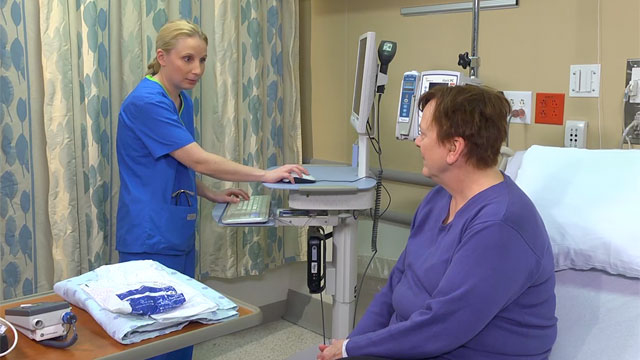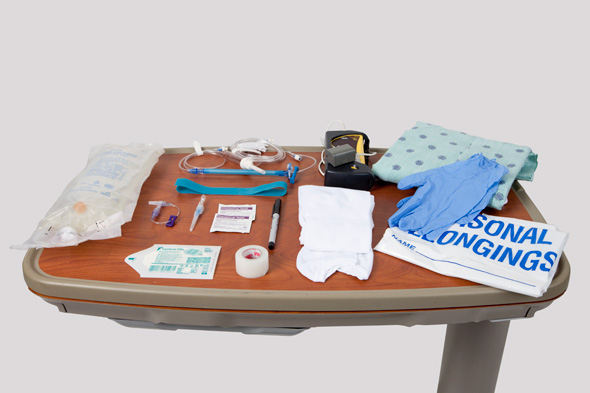Preoperative Nursing Care
Select a Skill:
- » Performing a Preoperative Assessment
- » Promoting Family Support and Participation
- » Teaching Postoperative Exercises
- » Preparing a Patient for Surgery
Take the Review Test:

Safety
- Identify the factors that increase the patient’s risks during surgery. Preoperative preparation and postoperative care depend on this knowledge. Know the rationale for and extent of upcoming surgery. Each type of surgical procedure requires a different type of nursing care.
- Patients who are illiterate can sign the consent form with a mark if properly witnessed. A parent or legal guardian must sign the consent form of individuals considered incompetent and of minors, unless they are married or have been declared emancipated. Refer to each state and institutional protocol for implementing informed consent.
- Ensure that informed consent is signed before giving preoperative medications. The times recorded on the consent form and on the medication administration record (MAR) must attest to this. Preoperative medications may alter the patient’s level of consciousness and thereby make the consent invalid.
- If the informed consent has not been signed and witnessed, or the surgeon and anesthesiologist did not provide the patient with information about the surgery and/or did not ensure that the consent forms were signed, the patient is not ready for surgery.
- If the patient did not remain NPO, which may indicate that the patient did not understand the instructions or forgot them, notify the surgeon and the anesthesiologist. The surgery may need to be postponed or canceled.
- Restrict the patient’s activity after administering preoperative sedatives, to minimize the risk of falling.
- Ask the surgeon which medications have been ordered to be taken preoperatively. Ask if any of the patient’s usual medications, including herbals and aspirin, can be taken. Help the patient take permitted medications with sips of water (30 mL).
- Apply tape over wedding rings that cannot be removed. Be sure the tape does not impede circulation.
- Report and document any vital signs outside of the normal range or the patient’s baseline to the anesthesiologist/surgeon. These may postpone surgery. Document any action taken.
- Ask the patient to repeat the instructions you have given. If he or she is unable to do so, either your earlier assessment of the patient’s level of understanding was inaccurate or the method of instruction used was ineffective. Revision of the instruction is necessary.
- If the patient did not void before receiving preoperative medication, assess for renal dysfunction and bladder distention. If distended, have the patient use a urinal or a bedpan, or order catheterization.
Equipment
(Roll cursor over items to see labels)

Pulse oximeter
Patient gown
Bag for patient's belongings
Antiembolism stockings
IV solution and tubing
IV solution and tubing
IV angiocatheter
Tourniquet
Transparent IV dressing
Antiseptic swabs
Pen
Silk tape
Clean gloves
Delegation
The skill of preparing a patient for surgery may not be delegated to nursing assistive personnel (NAP). Each state has its own rules regarding the delegation of related skills. Following are examples of skills that may be delegated, depending on the scope of practice for NAP in your state:
- Perform basic infection prevention and control practices.
- Assist with care of the patient who requires monitoring or comfort measures.
- Assist with care of the patient with nausea and vomiting, or the patient who is receiving intravenous fluids and oral intake.
- Assist with care of the patient with thermoregulatory problems, including hyperthermia and hypothermia.
- Assist with care of the patient on continual antiembolism devices who requires assistance with ambulation.
Preparation
- Obtain a nursing history, and review the patient’s preoperative orders and test results. (For details, see the Video Skill “Performing a Preoperative Assessment.”)
- Identify the patient using two identifiers, such as the patient’s name and birth date or name and account number, according to your agency’s policy. Compare the identifiers in the MAR/medical record with the information on the patient’s identification bracelet, and/or ask patient to state his or her name.
- Determine the patient’s ability to answer questions about his or her health history and the planned surgery.
- Discuss advance directives with the patient and family. If the patient has a DNR order and has opted to alter it during the intraoperative period, ensure that the medical record clearly indicates when the DNR order is to be reinstated.
- Identify surgical risk factors, medications, and history of allergies.
- Perform a physical examination. Focus on the body systems that surgery will affect, including a comprehensive pain assessment.
- Apply an allergy/sensitivity band and other applicable safety bands.
- Explain all procedures, and ask the patient and family about their knowledge of the surgery and their expectations. Ask about their fears, cultural practices, and religious beliefs as applicable.
- If the patient is a same-day admit or an ambulatory patient, validate that admission preparations have been completed as ordered. Specific preparations to review include NPO status, administration of medications, skin preparation, and bowel preparation as applicable.
Follow-up
- Have the patient describe the surgical procedure and its benefits and risks.
- Compare all assessment data with the patient’s baseline and expected normal levels.
- Have the patient repeat preoperative instructions.
- Monitor the patient for signs and symptoms of anxiety, and ask how the patient and family are feeling.
Documentation
- Document all preoperative assessment findings and preparations.
- Document the patient’s condition on transfer to the operating room.
- Document the presence of any allergies/sensitivities on the patient’s armband, in the medical record, and in the medication administration record.
- Record the disposition of the patient’s valuables/belongings, such as if they were locked up according to agency policy or sent home with the patient’s family.
- Report the lack of a signed and witnessed consent form or patient’s failure to maintain NPO status and any action taken.
- Report and record the patient’s cultural practices and/or religious beliefs that might affect perioperative care and any modifications made to the plan of care.
Review Questions
1. Why does the nurse place a patient on bed rest after administering preoperative medication?
 To ensure that the surgical site is not injured
To ensure that the surgical site is not injured  To protect the patient from injury
To protect the patient from injury  To maintain a calm environment
To maintain a calm environment  To maintain the intravenous infusion
To maintain the intravenous infusion
2. At what point would the patient sign the consent form for a surgical procedure?
 After the surgeon explains the procedure
After the surgeon explains the procedure  During the preoperative consultation at the surgeon’s office
During the preoperative consultation at the surgeon’s office  After receiving preoperative medication
After receiving preoperative medication At the completion of the physical examination
At the completion of the physical examination
3. A patient scheduled for same-day surgery tells the nurse that he had a “few sips” of coffee while driving to the hospital. What would the nurse do first with this information?
 Document that the patient had coffee
Document that the patient had coffee  Notify the operating room
Notify the operating room  Notify the surgeon
Notify the surgeon Inform the recovery room nurse
Inform the recovery room nurse
4. What might the nurse do to accommodate a patient’s request to wear a wedding ring during surgery?
 Explain that the ring may be lost during surgery
Explain that the ring may be lost during surgery Suggest that the ring be placed in the top drawer of the bedside stand
Suggest that the ring be placed in the top drawer of the bedside stand Recommend that family take the ring home
Recommend that family take the ring home Tape the ring to the patient’s finger
Tape the ring to the patient’s finger
5. After the nurse provides a patient with preoperative medication, the patient needs to void. What would the nurse do?
 Walk the patient to the bathroom.
Walk the patient to the bathroom. Insert an indwelling urinary catheter.
Insert an indwelling urinary catheter. Insert an intermittent urinary catheter.
Insert an intermittent urinary catheter. Provide the patient with a bedpan.
Provide the patient with a bedpan.
You have completed the Review Questions for this skill. To take the Review again select the Start Over button. To proceed to another skill select from the dropdown menu. Select the Home or Back button to proceed to the next section.

